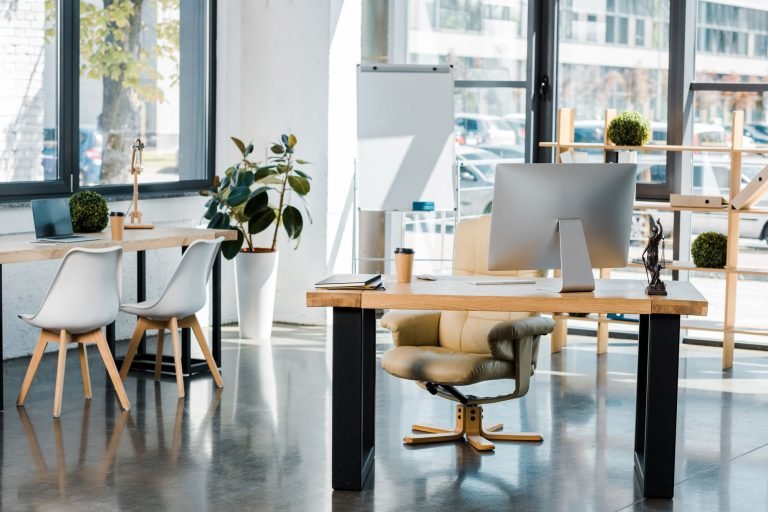A clean and organized office is essential for creating a productive, positive, and professional environment. Employees perform better in tidy workspaces, where reduced clutter allows for greater focus and efficiency. A well-maintained office also boosts morale, fostering a sense of pride and comfort among staff. For clients and visitors, a clean workplace leaves a lasting impression, reflecting the company’s attention to detail and professionalism.
Cleanliness goes beyond appearances—it’s vital for health and safety. Regular cleaning helps reduce the spread of germs, bacteria, and allergens, minimizing sick days and improving overall employee well-being. With hygiene being a top priority in modern workplaces, maintaining cleanliness contributes to a healthier, more enjoyable atmosphere. Air quality contributes to employee well-being, so consider air purifiers to filter and recirculate air, such as Alen commercial air purifiers.
Organize Workspaces Effectively
A well-organized workspace is essential for maintaining a clean and efficient office environment, a standard upheld by Think FM commercial cleaners. Assigning designated areas for paperwork, office supplies, and personal belongings reduces clutter and makes items easier to locate. Providing labeled storage bins, filing systems, and desk organizers helps employees maintain order while practices like digitizing documents minimize the accumulation of physical files.
Tidy desks benefit both employees and the overall office environment. Clutter-free surfaces enhance focus by reducing distractions and fostering a sense of order, boosting productivity. Additionally, organized workspaces create a professional atmosphere, leaving a positive impression on clients and visitors.
Shared spaces, such as meeting rooms and communal storage areas, should also have clear organization systems. Regular reviews and decluttering of these areas ensure they remain functional and inviting.
Choose the Right Cleaning Supplies
Choosing the right cleaning supplies is essential for maintaining an effective and safe cleaning routine. Select products that are both effective at removing dirt and germs and safe for the surfaces they’ll be used on. For instance, glass cleaners work best for windows and mirrors, while multi-purpose cleaners handle general surfaces like desks and countertops.
Eco-friendly and non-toxic cleaning products are excellent choices for promoting a healthier workspace. These alternatives reduce exposure to harsh chemicals, benefiting employees with allergies or sensitivities and supporting sustainability goals. Look for products certified as environmentally friendly or biodegradable to ensure minimal impact on the environment.
Develop a Regular Cleaning Schedule
A regular cleaning schedule is essential for maintaining a clean and organized office. Consistency helps prevent the buildup of dirt, dust, and clutter, ensuring a healthier and more productive work environment. Establishing a structured routine divides tasks into manageable intervals, making it easier to keep the office in top shape.
Daily tasks should include emptying trash bins, wiping down desks, and sanitizing high-touch surfaces like door handles and keyboards. Weekly responsibilities can focus on deeper cleaning, such as vacuuming carpets, mopping floors, and disinfecting shared equipment like printers or coffee machines. Monthly duties might involve tackling less frequent but essential tasks, such as cleaning windows, organizing storage areas, or deep-cleaning upholstery.
Encourage Employee Participation
Involving employees in maintaining a clean office fosters responsibility and teamwork while reducing the overall burden on cleaning staff. Simple habits, like cleaning up after meals, organizing personal workstations, and promptly disposing of waste, can significantly contribute to a tidy workplace. Encouraging these practices not only keeps the office clean but also promotes a sense of pride and ownership among employees.
To cultivate a team-oriented approach, establish clear expectations for cleanliness, such as keeping shared spaces like meeting rooms and break areas tidy. Provide the necessary tools, such as sanitizing wipes and recycling bins, to make participation easier. Consider implementing friendly competitions or offering incentives to reward employees for their efforts in maintaining cleanliness.
Pay Attention to High-Touch Areas
High-touch areas such as door handles, keyboards, light switches, and shared office equipment like printers or telephones are hotspots for germs. These surfaces are frequently used by multiple people, making them prime locations for the spread of bacteria and viruses. Regular sanitization of these areas is critical for maintaining a healthy workspace and reducing the risk of illness among employees.
Use disinfectant wipes or sprays specifically designed to eliminate germs on hard surfaces. Make sanitizing these areas part of the daily cleaning routine to ensure they remain safe for everyone. Encourage employees to clean personal items like keyboards, mice, and phones regularly as well.
Optimize Waste Management
Effective waste management is essential for maintaining a clean and environmentally friendly office. Proper waste segregation helps ensure recyclable, compostable, and general waste are disposed of correctly, reducing landfill contributions. Place clearly labeled bins in accessible locations, such as break areas and near desks, to encourage compliance.
Regular trash removal is equally important to prevent unpleasant odors, pests, and overflow. Schedule daily disposal for general waste and weekly pickups for recycling. Educate employees about what can and cannot be recycled to minimize contamination in recycling bins.
To further reduce waste, encourage practices like using reusable containers, mugs, and cutlery instead of disposables. Promote digital workflows to minimize paper usage and ensure unused office supplies are repurposed rather than discarded.
Hire Professional Cleaning Services
Professional cleaning services offer a level of expertise and thoroughness that routine office cleaning often cannot achieve. These experts are equipped with specialized tools and techniques to deep-clean areas that accumulate dirt over time, such as carpets, windows, and upholstery. Tasks like stain removal, floor polishing, and sanitizing high-traffic areas require professional-grade equipment and skills, ensuring a superior result.
Outsourcing these responsibilities also saves time and resources for businesses. Professional cleaners work outside regular office hours, minimizing disruptions to daily operations. Additionally, they adhere to industry standards for hygiene and safety, which is especially crucial for disinfecting shared spaces and high-touch surfaces like doorknobs and desks.
Maintain Air Quality
Clean air is vital for employee health, comfort, and productivity. Poor air quality, often caused by dust, allergens, or inadequate ventilation, can lead to health issues like respiratory problems and fatigue, ultimately affecting workplace efficiency.
To maintain optimal air quality, consider installing air purifiers equipped with HEPA filters to reduce airborne pollutants. Regularly clean and replace HVAC system filters to ensure proper circulation of fresh air throughout the office. Proper ventilation is equally important; open windows when weather permits to allow natural airflow and prevent the buildup of stale air.
Plants can also enhance air quality by absorbing toxins and releasing oxygen, making them a cost-effective and visually appealing addition to the workspace.
Investing in air quality solutions not only creates a healthier environment but also boosts employee morale and productivity, ensuring a more pleasant and efficient workspace.
Keep Break Areas Clean
Keeping kitchens and communal areas clean is crucial for maintaining a healthy and inviting workplace. These spaces often see high foot traffic and can quickly become breeding grounds for germs if not properly maintained. A clean break area contributes to employee well-being and fosters a sense of respect for shared spaces.
To maintain cleanliness, ensure food storage is well-organized. Provide labeled containers for employees to store their food properly and minimize clutter in refrigerators. Regularly clean appliances like microwaves, refrigerators, and coffee machines to prevent buildup of food residue or spills.
Encourage employees to clean up after meals by wiping down counters and disposing of trash in designated bins. A team approach, where everyone takes responsibility for keeping the space tidy, ensures the break area remains pleasant for all.
A clean and well-maintained break area enhances overall office hygiene, providing employees with a comfortable and hygienic space to recharge.
Monitor Progress and Adjust Strategies
Regularly assessing the effectiveness of cleaning routines ensures that the office remains consistently clean and efficient. Establishing a system to monitor progress allows businesses to identify areas that may need more attention or adjustment. For example, if certain spaces become dirtier faster than others, they may require more frequent cleaning or better organization.
Encourage employees to provide feedback on the cleaning process, as they are the most familiar with specific areas that may be overlooked. Consider conducting occasional surveys or team discussions to gather input and address any concerns.


































